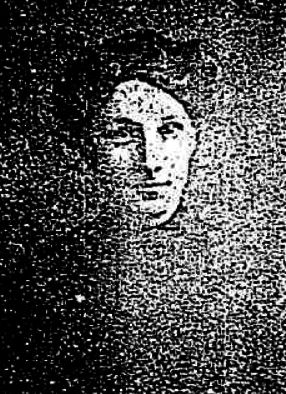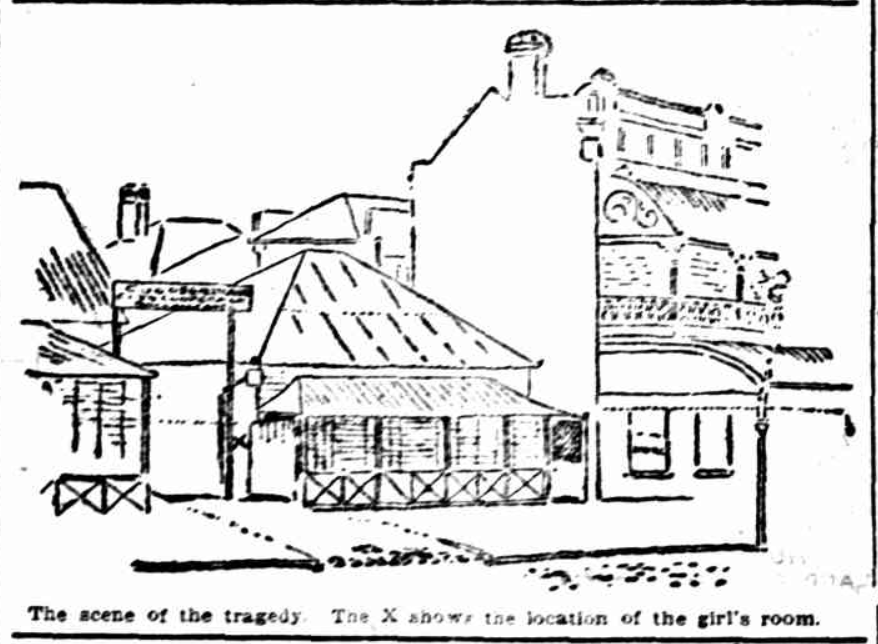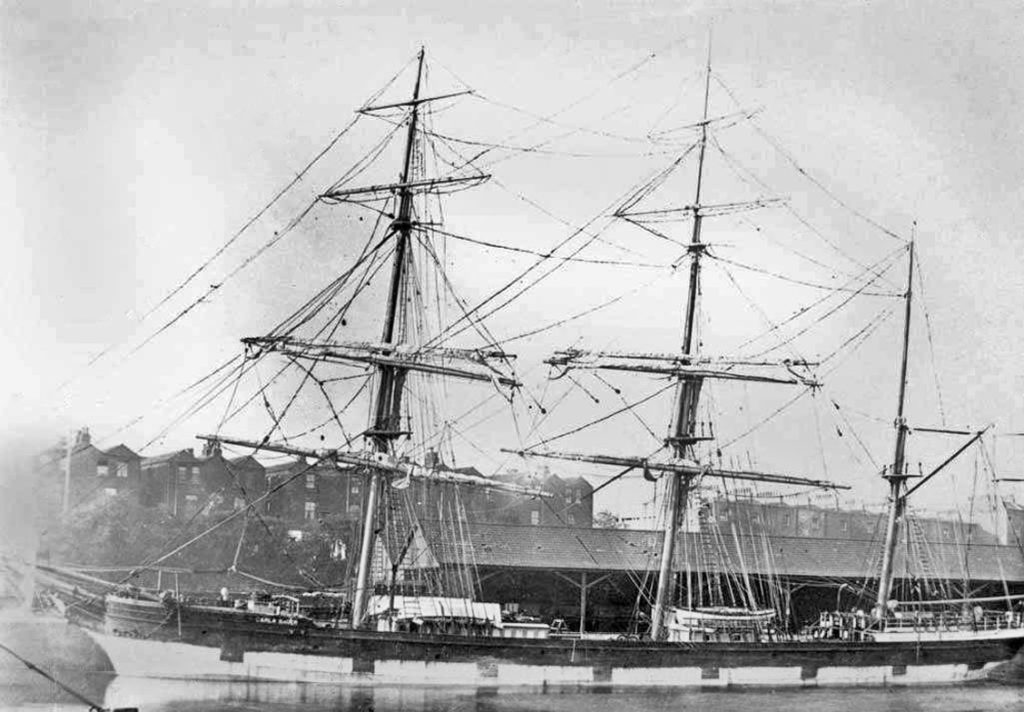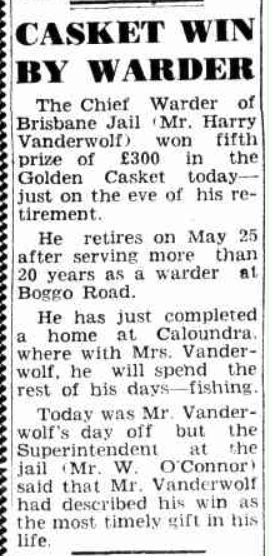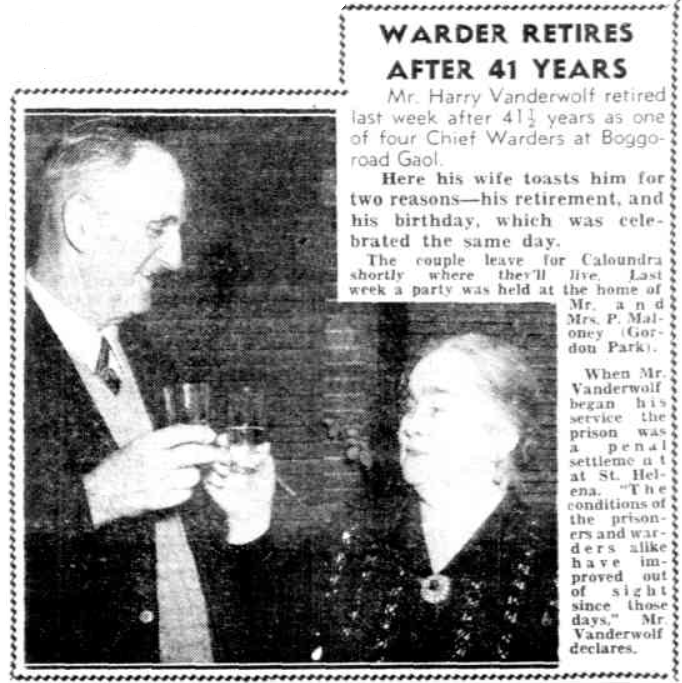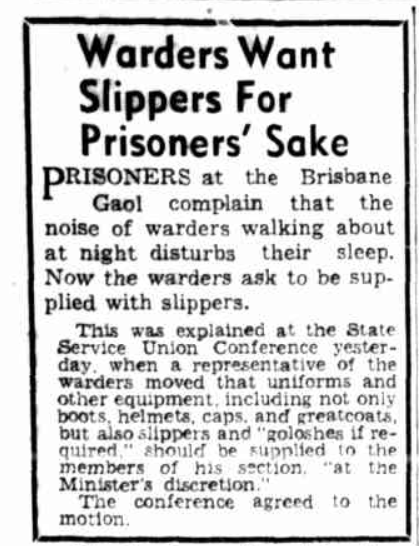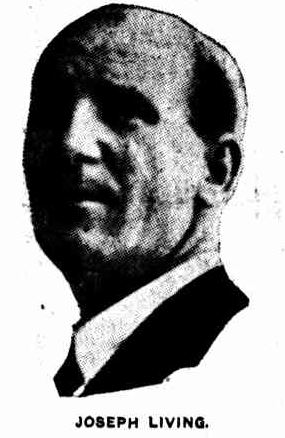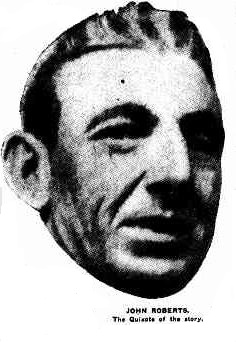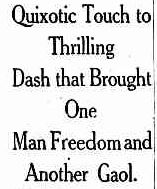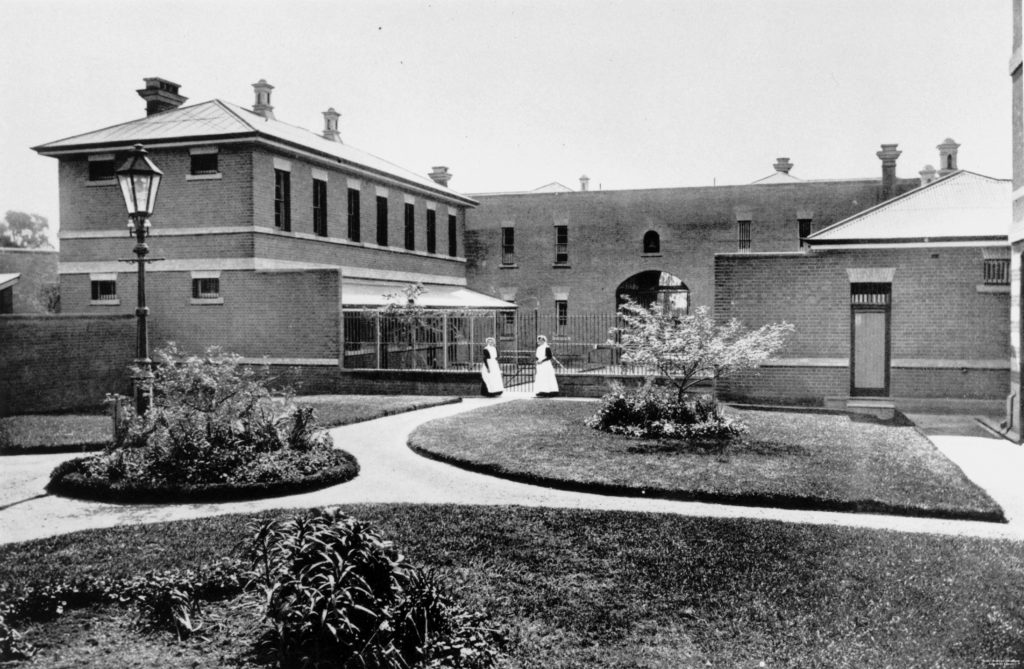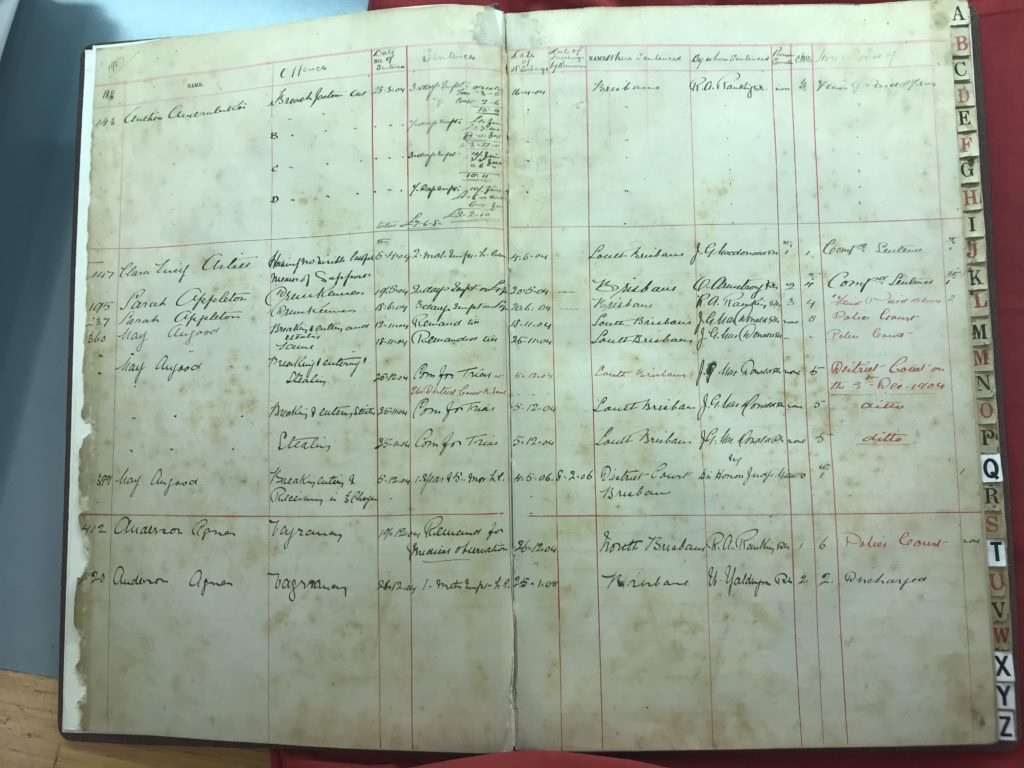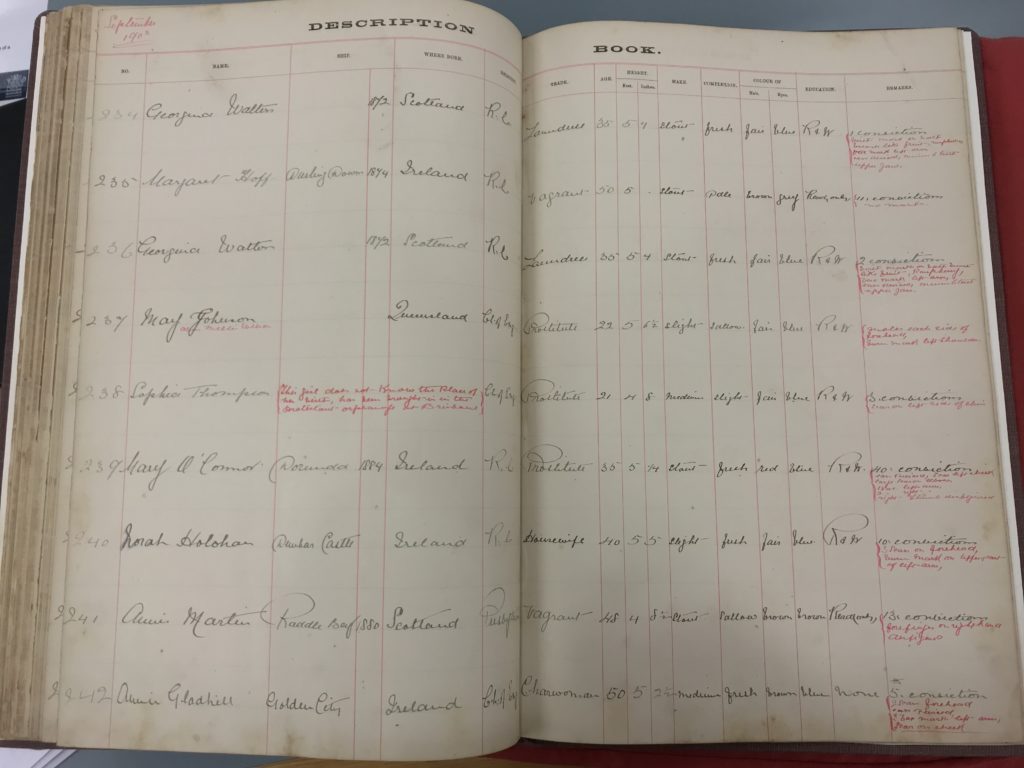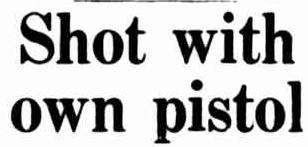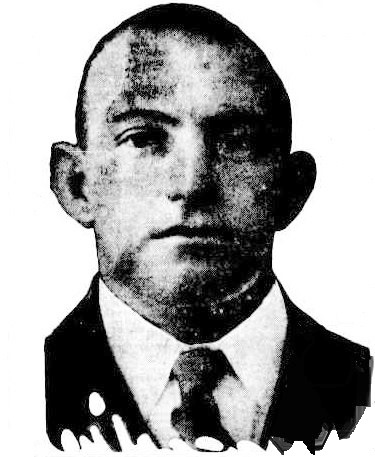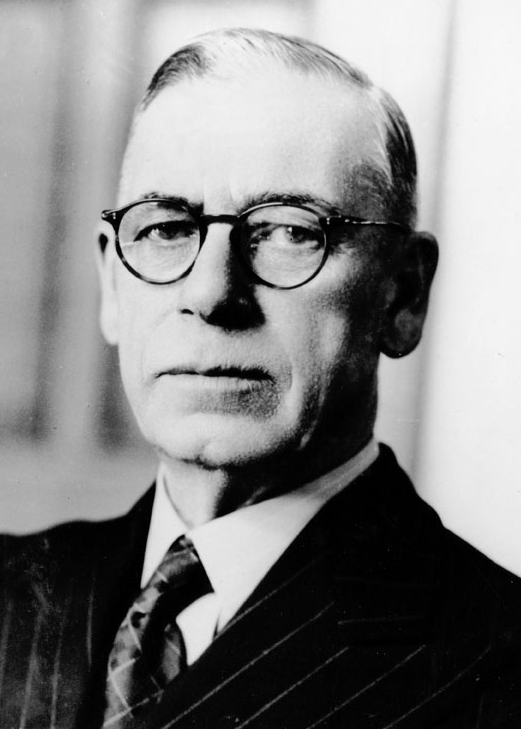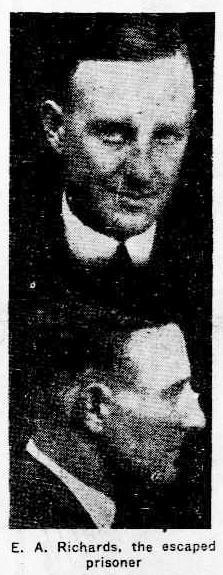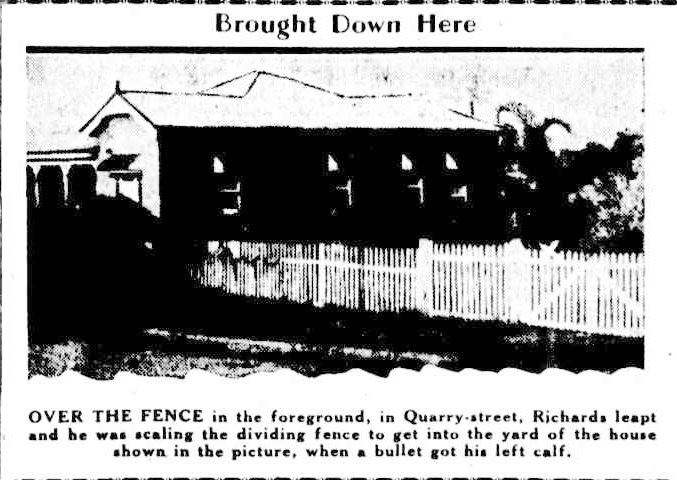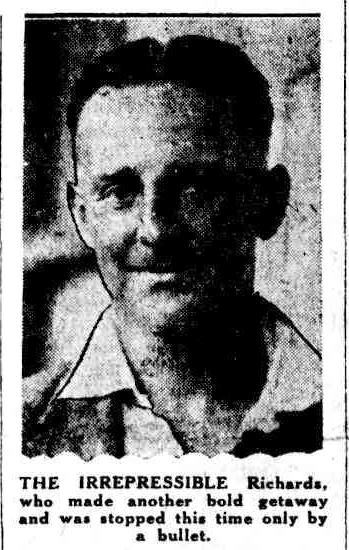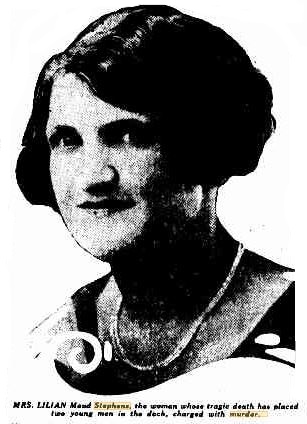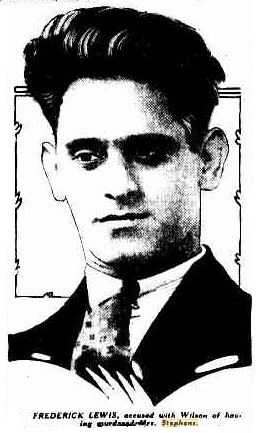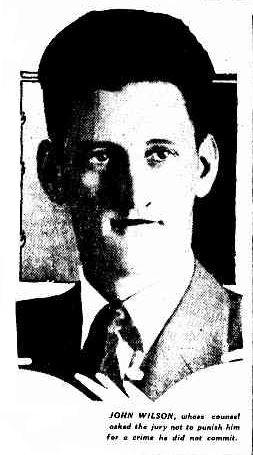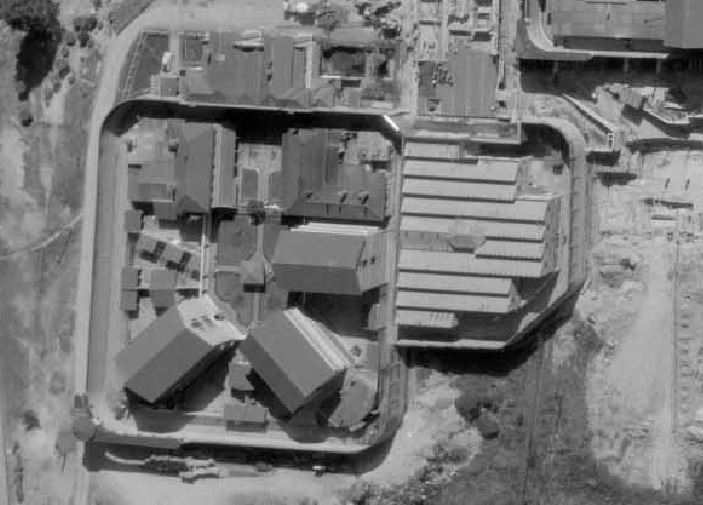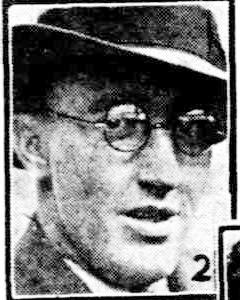Juett sisters – The tragic life of Lily Juett
- On : 29 June, 2018
- By : Boggo Road Gaol
- Category : Stories
- View : 2842
Juett sisters – The tragic life of Lily Juett
Young women of poor origins quite frequently found themselves falling afoul of the law. Her Majesty’s Prison for Women Brisbane at Boggo Road was where most of these women ended up.
The Juett sisters were no exception. Minnie and Lily Juett were natives of Bundaberg, North Queensland. Their parents had nine children and were of simple farming stock. The children were sent out to work as soon as it was suitable. Minnie and Lily were sent to work as servants in some of the finer homes and their brothers as labourers on farms around the Rockhampton and Bundaberg region.
Minnie and Lily were not long in their new profession, both having been discharged for theft and improper conduct. Both could not return home and turned to the streets to make their living. After some time had passed, the sisters had saved enough money that they made their way by ship to Brisbane; hoping to change their futures for the better.
Today, we are going to turn our attention to the youngest of the two sisters, Lily Juett.
Lily Juett
Native Place: Bundaberg, Queensland.
Age: 20 years 11 Months
Height: 4 feet 8 ½ inches (143cm)
Weight: 6 stone 10 lbs (42.6kg)
Make: Slight
Complexion: Pale
Hair: Fair
Eyes: Blue
Marks: Three vaccination marks on left arm and scar on left temple.
Before the court
Lily was only just sixteen years old when she first ran afoul of the law. Being charged with the common offence of Vagrancy. The police magistrate took pity on her, her situation could only be described as terrible, and he sent Lily to the Salvation Army Home for wayward ladies. It mustn’t have had much effect; for just six months later Lily was again before the court, charged with having no lawful means of support. Again, she was sent to the Salvation Army Home.
This was the beginning of a downward spiral for Lily. She was found in one of the more notorious brothels in town, George Antoni’s Oyster Saloon on Albert Street. She with other young girls were attracted to Antoni’s by the offer of free food and lodging. Little did these young girls know, they had to work for their keep in the most degrading way.
Antoni’s was regularly in the press and often raided by the police and the health department as a house of ill fame. Lily would continue to reside at Antoni’s often over the next two years.
In 1906, Lily was charged with quitting the lock hospital and breach of the communicable diseases act. Two laws that prostitutes were regularly charged with having broken. Lily spent most of 1906 in gaol after numerous small offences.
We next hear from Lily in June of 1908 when she is charged with having created a public disturbance in Albert street and for damaging a policeman’s trousers while engaged in a scuffle. She was given a fine or 7 days in gaol. Lily chose gaol.
Again, in September of 1908 Lily was in court. This time having been charged for being armed in public with no lawful reason. She had allegedly fired several shots into the air in Albert Street. Luckily for Lily, not enough evidence was available to proceed, and the case was dismissed. It wouldn’t be long however until Lily’s luck would run out.
Mary Street Tragedy
10:30pm , Monday 31st May 1909, O’Brien’s cottage, 82 Mary street, Brisbane.
From the headlines of The Truth.
Shortly after 10:30pm in a dingy cottage adjoining the Oriental Hotel on the corner of Mary and Albert Streets, Brisbane. Shots rang out.
A witness screamed… “Someone is shooting Lily” The ladies of the cottage ran to her aid. Only to find the door barricaded from the inside. Thelma Woods, a single woman, who lived in the room next to Lily poked her head through an open window seeing Lily on the floor and turning to see a man blocking the door before he turned the gun on himself and fired. She screamed and ran to meet Constable Roche who having heard the shots was making his way toward her.
Earlier that evening, Lily and the unknown man had been sharing drinks at the Oriental Hotel. They seemed very friendly and at closing time were very drunk. It would later be known that Lily had previously been in a relationship with the seafaring, powerfully built man. She had received word that he was arriving at Pinkenba. He was an engineer on a ship called Strathspey.
That evening after their day together, Lily announced that she had been keeping company with another man and that his case was hopeless. She intended to marry her lover. This is said to have thrown the man into a rage and quite possibly have caused the crime.
Just before entering her room that night, she had told another of the ladies of the cottage that should anything happen to her that night, to tell her lover that she loved him to the last.
It was not long until a crowd had formed surrounding the cottage and news had reached another lady of the evening, Minnie Juett. Minnie came rushing forward, eventually being allowed into the room by the police. When she saw her little sister lying on the floor covered in blood, Minnie cried out and was carried from the room by the kindly officers. She communicated with her mother who at once made for the scene from Bundaberg.
The subsequent magisterial inquiry and post mortem would show that poor Lily had been shot twice in the head and once in the chest at extremely close range. Her death was instant.
It would also prove that the man identified as Karl or Carl Eberhardt (alias August Hesse) was in possession of a five chambered revolver and a pocket watch when spoken to by police in Newcastle New South Wales some months previously. These items were found in the room along with other personal effects with the name Carl Eberhardt. It was conclusive, it was he that fired the fatal shots and murdered Lily before turning the gun on himself.
The Truth newspaper published the most complete coverage of this story. The editor summed up this tragic tale of woe with the inventory of Lily’s worldly possessions.
“For any young ladies having any doubts on the Fairy Tales of the earnings of vice, the inventory of her possessions will round out this tale of vice, debauchery, degradation and death. In hard cash, £1 and 13 shillings, of which 3 shillings and 6 pence were from her last transaction on earth. Lily Juett was young just on the verge of 21. Her only other possessions included: one umbrella, three blouses, one petticoat, one chemise, one singlet, one pair of stockings, one pair of slippers, one chain purse (empty), one steel belt, one string of beads and a pawn ticket for a ring in the name of Miss Wilson.
That inventory is a better homily on the folly and degradation of vice than all the sermons that were ever preached and comment of any sort would lesson not increase its effect.”
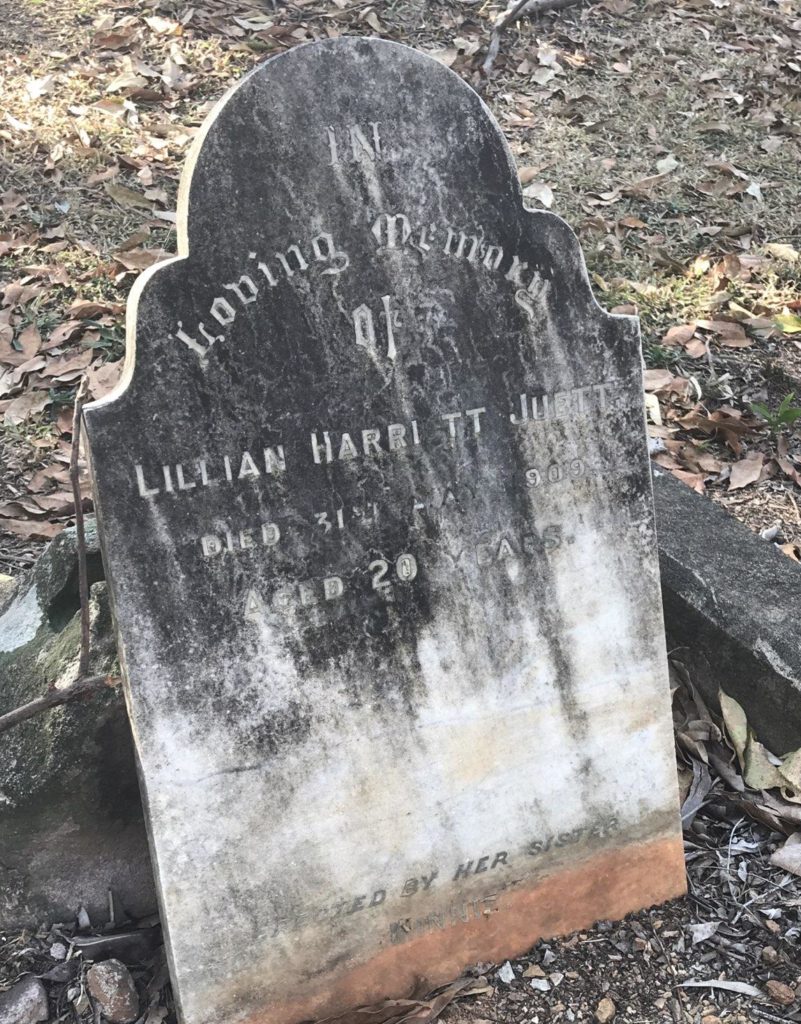
For many ladies that have at one time seen the inside of the walls at Boggo Road Gaol, this life would be all too familiar. Not all ended so tragically. Some would say though that living numerous years longer in the same daily cycle of degradation and despair would be much worse.
Of all the charges passed on the women in the earliest days of the female division, the vast majority had a charge for Prostitution. Often listed in the registers as vagrancy, without visible means of support, offensive language and public disturbance. It was very common, and a sad commentary on society of the time.
Want something cool to do this Sunday? Learn more about the women at Boggo Road Gaol by taking an 11am History Tour and watching our Prison Players perform! You can book your tickets here
This article was contributed by Research Coordinator Sue Olsen as part of the ongoing research program for Boggo Road Gaol Pty Ltd. The aim of the program is to bring to light and share articles relating to Boggo Road for the purposes of review and study. Do you have a story to share or something you would like us to know about? You can contact the research team here
From the headlines Officer retires after 41 years
- On : 21 June, 2018
- By : Boggo Road Gaol
- Category : Stories
- View : 2361
From the headlines… Officer retires after 41 years
Chief Warder Henry ‘Harry’ Victor Vanderwolf
‘Harry’ retired on the 25th of May 1953, just one day after his sixty-fifth birthday. He and his wife retired to 4th Avenue in Caloundra where they can be found into the 1970s. Indeed, it would have been a wonderful sea change for a man who worked inside brick walls and iron bars for most of his days.
Henry Victor Vanderwolf, known as Harry, was born in Maryborough to John Rowe Vanderwolf and Jane Ann Payne. His parents had emigrated with his older siblings from Cornwall in England on the Duke of Athol in 1881. The family set up home in Maryborough and proceeded to live there for over fifty years.
Harry was one of a large family of ten children, eight of whom were sons. He had a large family already here in Queensland with his fifty plus cousins. Frustratingly for the researcher… they all had a Harry.
Harry joined the prison service shortly after his 22nd birthday, officially recognised as a probationary warder in the Queensland Government Gazette of 1912. It is unconfirmed where he spent his first few months in the service, although it is likely it would have been in the Brisbane lockup. By the time Harry completed his probation, he was transferred to the notorious St Helena Island. Known for its harsh conditions both on officers and prisoners alike, St Helena would have been no easy mark. Certainly, St Helena would prove useful to Harry as his career was to progress.
In addition to relatives in Queensland, the Vanderwolf clan had made their way south of the border into the suburbs of Sydney, New South Wales. It was here, on summer vacation in 1917 he would find his sweetheart in Christina Ellen Mitchell; they were married a few months later in Marrickville, New South Wales.
At the end of the war, Harry had set the family up and had returned to his post at St Helena Island. It would not be long before a daughter would grace their little home. So onwards time went, Harry had seen his friends and family go off to war and come home greatly changed. It wasn’t long until his life would be profoundly changed too, in a good way!
In the newspapers of the day, numerous entries can be found talking about the prison at St Helena Island. There had been murders, terrible assaults, formal complaints and disciplinary action; it truly was a hell hole for everyone. Succumbing to overwhelming pressure, it was clear something had to be done. St Helena would be closed as a maximum security prison, and the prisoners moved to the female division at HM Prison Brisbane (later known as Boggo Road Gaol). The female inmates were transferred to another section of the Gaol to make way for the men. For Harry, this was a most unexpected windfall.
HM Prison Brisbane 
Harry was moved to his new station at HM Prison Brisbane with one of the first loads of men to be transferred. It would prove to be a great move. Just ten years later, Harry climbed the ranks to be Chief Warder of Boggo Road Gaol, a position he would go on to hold for the next twenty years.
Just after Christmas in 1932, Harry was promoted to Chief Warder at Boggo Road. The family celebrated and moved into their new home, the quarters of the prison. This indeed was a step up socially and personally. Sadly though, things were to take a sad turn. His beloved wife passed away aged just 47 years. Christina Ellen Vanderwolf was laid to rest at the Lutwyche Cemetery.
Again, the years moved on, each day entering those gates at the prison and looking after some of society’s worst characters.
A few years later at a church social, he was to meet the future Mrs Vanderwolf. Eliza Linda Letty Uhllman, a spinster and a bit younger than Harry, caught his eye and the rest would be history. They were married in 1939, just at the beginning of yet another world war.
Indeed, his own daughter joined the service, it is not known what exactly she did as her records are not open for viewing.
Harry, however, had an eventful next year, becoming instrumental in the apprehension and conviction of Ernest Arthur Halliday or ‘Slim’ as he was known around the Gaol. In February of 1940, Slim would make the first of his two escapes. Harry was the officer that found a rope hanging from the prison wall. Halliday had escaped over it all right. The rest of this story you will hear on your tour, so I will leave it there for now. Harry would raise the alarm and would be involved in this story for years to come.
In 1948, with just a few years to go before compulsory retirement, Harry was again promoted to Chief Warder second class, which would certainly have been a pay increase and perhaps other long-term benefits as well. It is here we lose Harry for a few years before he reappears in the papers.
Casket Win
Remarkably, just shy of his retirement, Harry collected a handsome Casket win. Fifth prize of £300 to be exact. It would certainly be nice to add to the retirement fund. Harry remarked that it had been the most timely gift of his life. He had just finished building his retirement home at Caloundra where he intends on spending his time fishing.
Retirement
Harry retired on the 25th of May 1953, just one day after his sixty-fifth birthday. He and his wife retired to 4th Avenue in Caloundra where they can be found into the 1970s. Indeed, it would have been a wonderful sea change for a man who worked inside brick walls and iron bars for most of his days. In all, Harry served 41 and a half years in the prison service, which by today’s standard, is an eternity. Harry lived at Caloundra until he died in 1976. He is buried with his wife at the Caloundra Cemetery.
Want to know what it was like to be an officer at Boggo Road Gaol? Come along this Sunday for our Officer tour and meet Former Officer Kevin Hayden! For more information click here
This article was contributed by Research Coordinator Sue Olsen as part of the ongoing research program for Boggo Road Gaol Pty Ltd. The aim of the program is to bring to light and share articles relating to Boggo Road for the purposes of review and study. Do you have a story to share or something you would like us to know about? You can contact the research team here.
Officer’s requests
- On : 15 June, 2018
- By : Boggo Road Gaol
- Category : Stories
- View : 2138
Officer’s requests
Some would say that Prison Officers have one of the toughest jobs in the world. Everyday they enter the world behind bars and work with some of the worst of the worst. Ever wonder what it takes to do the job? Well in this week’s article we talk about the prison service and the role that officers had in shaping the correctional institutions in Queensland as we know them today.
Officer’s requests
Some would say that Prison Officers have one of the toughest jobs in the world. Every day they enter the world behind bars and work with some of the worst of the worst. Ever wonder what it takes to do the job? Well in this week’s article we talk about the prison service and the role that officers had in shaping the correctional institutions in Queensland as we know them today.
Prison Service in Queensland
The prison service in Queensland is one of the foundation departments formed when Queensland was separated from New South Wales in 1859. Officially forming in 1860 the service was represented by various small gaols, penal establishments and lock ups in the colony. These were all under the management of the Sheriff of Queensland. Sounds a bit like the wild west doesn’t it? In 1887 a commission into the management of the various gaols, penal establishments and lockups in Queensland brought about a sweeping change. The report recommended the consolidation and amendment of legislation to make room for the creation of the Prison Service and the appointment of the Controller General to manage all prisons in the colony.
These changes would not happen quickly, it takes quite some time to make significant changes to legislation. The Prisons Act of 1890 would be the eventual result. The act will be the first of many changes over the coming decades.
The changes in the management of prisons in Queensland would mean the hiring and retraining of staff. These continual changes in expectations over the life of HM Prison Brisbane later known as Brisbane Correctional Centre or Boggo Road Gaol were posted on the wall for officers to see and apply as they happened. A copy of the vast majority of these are kept in a fascinating series of records held at the Queensland State Archives. These records were held in each of the prisons in Queensland.
Prison Rules and Orders Book: 1869-1961 – Brisbane Correctional Centre.
Description:
Books of letters, circulars and memoranda from the Sherriff of Queensland and later the Controller General of Prisons to the Superintendent of the Brisbane Gaol later known as HM Prison Brisbane or the Brisbane Correctional Centre.
So, what happened if you didn’t follow the rules? Well, you would be officially charged, and the details recorded in an equally fascinating series the Register of officials and warders and defaulters book 1865-1947. The punishment being anything from being docked a day’s pay, to dismissal and even a prison sentence!
Prison and Asylum Workers Union
Just like any other union, it is set out for the purposes of protecting the rights of workers. Founded in 1915, it was the beginning of the union movement in the prisons and asylums in Queensland. In August of 1915 the inaugural conference was held in Trades Hall, Brisbane. The first conference set out the rules and regulations of the union and elected a committee. In attendance were representatives from all the gaols, penal institutions, lockups and asylums in Queensland. It certainly must have been an impressive turn out.
As an outcome of the conference, the subsequent report set some of the foundations of the modern system of employment in the correctional services industry. Indeed, you will probably recognise some items that are still in practice today and some that are still under negotiation in most industries a century later.
- A 40-hour week
- Salary increases
- Night shift allowance
- Overtime
- Vacancies posted in the Government Gazette
- Equal pay for male and female employees
- No extra duties for night staff
- Charges made in writing – what we later know as a written warning.
The conference committee then approach the Sherriff or later the Controller General for approval of the items discussed. The conferences held under the Prison and Asylum Workers Union continued until 1918, when the two were separated. These unions are now covered under the Australian Workers Union.
 Sublime to the ridiculous?
Sublime to the ridiculous?
An article published in the Courier Mail Newspaper in August of 1939 dealt with the need for prison officers to have slippers… so as to not wake the prisoners at night! Of course, at the minister’s discretion! Whether or not this ever came in, is not yet known. But we will keep you posted!
Want to know what it was like to be an officer at Boggo Road Gaol? Come along this Sunday for our officer tour and meet former officer Kevin Hayden! For more information click here
This article was contributed by Research Coordinator Sue Olsen as part of the ongoing research program for Boggo Road Gaol Pty Ltd. The aim of the program is to bring to light and share articles relating to Boggo Road for the purposes of review and study. Do you have a story to share or something you would like us to know about? You can contact the research team here.
Escape! – Percy Lee
- On : 9 June, 2018
- By : Boggo Road Gaol
- Category : Stories
- View : 1799
Escape! Percy Lee
Percy was a ‘dip artist’ (pickpocket) and a good one. Percy served numerous short sentences in gaols’ all over New South Wales; all for theft in one way or another. Escaping the heat from his crime, Percy ventured over the border into Queensland.
Escape! Percy Lee
Description:
Age: 28
Height: 5ft 10 inches
Weight: 12stone 8lb
Hair: Dark Brown
Eyes: Brown
Complexion: Sallow
Build: Proportionate
Marks: Four vaccination marks on Left forearm.
Cut right side of forehead. Scar left forehead, scar on each knee.
Occupation: Tailor
Native Place: New South Wales
Aliases: James Lee, Percy John Lee.
Percy Lee was born into a large family living in Merriwa, New South Wales. His father, a farmer, and his mother, who worked home duties, raised him in a good catholic family. Percy was well educated and worked the family farm from a young age and later as a jockey riding in the local race meetings. In 1914 war broke out and the losses were heavy. As war entered its second year, reinforcements were called for. Percy lied about his age so that he could enlist. He was only sixteen when he was sent to France. Twice wounded in action, he returned home at the end of 1918.
Back home, the great depression had hit. There were no jobs, especially for young men with war wounds that were unable to work doing physical labour. This was when Percy first had his run in with the law.
Percy was a ‘dip artist’ (pickpocket) and a good one. Percy served numerous short sentences in gaols’ all over New South Wales all for theft in one way or another. Escaping the heat from his crime, Percy ventured over the border into Queensland.
It wasn’t long until the arm of the law reached Percy. Percy Lee was charged on the 8th of May 1926 with two counts of stealing. The police magistrate sentenced him to six months for each charge to be served cumulatively. Off in the black maria to her majesty’s prison (Boggo Road Gaol) he went. Just two short weeks later, he would meet John James Roberts, also in for stealing. Roberts was in for six months, however, he could reduce his sentence by paying a fine if he could get the money together. In the meantime, Percy and Roberts put their heads down and were of best behaviour. They became good pals. Thick as thieves, so they say.
Their friendship didn’t long get started when Roberts was released on the 19th of June; he had raised the funds to pay the fine. To Percy, all was lost. His mate was gone, but he knew what he had to do. He had to keep his head down and be on his best behaviour. He had to get out of there.
The Escape
At 10:40 am on Monday the 16th of August, 1926 Percy was engaged in repairing a fence outside of the gaol walls under the supervision of an armed warder. Just then, a speeding dark yellow motor car was driven up and swerved around as Lee sprang to his feet and onto the footboard and slid into the car. The car sped away in the direction of the city carrying its four occupants. The warder, realising what has happened fired his revolver, the bullets struck the car twice, but without much effect. Percy had escaped. The alarm was sounded, and the area was quickly swarming with police and warders from the prison.
The next afternoon, a pair of prison trousers, a black vest and leather braces that the prisoner was wearing at the time of his escape, were found in Grey street, South Brisbane.
Over the coming months, it would become clear that Percy was gone. He certainly wasn’t in Queensland and the authorities have not found trace of him in his home state of New South Wales. Where had he gone?
The Investigation
The investigations were continuing in Brisbane; how had he got a message out from inside the prison? How had he set up the escape at that exact time? The police put out a request for information. Weighing heavily on his mind, a taxi driver of Russian heritage named Alexander Douglas stepped forward. He admitted that he was the driver of the car that aided the escape of Percy Lee.
Detectives badgered Douglas for hours; he explained that he was threatened into driving the car by another man, John Roberts. He explained how Roberts wound cloth over the number plate of his cab so it wasn’t seen. Roberts had arranged everything, even clothing for Percy to change into.
A patrol car was sent to collect John James Roberts. He was charged with having aided and abetted Percy Lee, however, not before he had named the fourth man in the vehicle, Joseph William Living, a friend of his. A wharf labourer residing at New Farm, Living was sent for. However, he denied he knew anything at all about the plan. The first he knew of it was at the moment it was happening.
Living protested his innocence. Finally, Roberts confessed that he had cooked up the plan with Percy Lee while he was inside Boggo Road. He had received a message over the weekend that the work on the fence would be completed soon… and Monday was the day.
Just how that message got out of the Gaol is a matter that is lost with time. Roberts and Living were charged with having aided and abetted Percy Lee. Roberts pled guilty, adding the statement that Living had nothing whatsoever to do with the escape, he had just been in the car at the time. Living was released. Roberts gained another year in Boggo Road.
Capture
Seven long months later, in March 1927, a police officer in New Zealand spied a man that looked familiar. It was the escaped prisoner from Australia, Percy Lee.
Percy was returned to Australia. Though not to Brisbane; Percy had an outstanding warrant for his arrest in Sydney on the charge of serious assault and robbery. Percy was to be lodged in Long Bay Gaol for the next twenty three months, with the Queensland authorities waiting to bring him back to finish his seven months in Boggo Road. He never did return to Queensland. Instead, he married and spent the rest of his life with a sickly, emotionally tormented wife and no work. He loved her, but she needed help that he could not afford to give her. Consequently, Percy was in and out of prison. His wife died tragically young. Percy was in and out of prison into the forties, before finally disappearing from the records forever.
Want to see where Percy Lee escaped? You can! Join us for our Escapes tour this Sunday! Hosted by Director Jack Sim, you will hear of some of the greatest escape stories from the history of Boggo Road Gaol. To book click here
This article was contributed by Research Coordinator Sue Olsen as part of the ongoing research program for Boggo Road Gaol Pty Ltd. The aim of the program is to bring to light and share articles relating to Boggo Road for the purposes of review and study. Do you have a story to share or something you would like us to know about? You can contact the research team here
From the Archives – HM Prison for Females
- On : 1 June, 2018
- By : Boggo Road Gaol
- Category : Stories
- View : 2370
From the Archives – HM Prison for Females
His Majesty’s Prison for females (later known as number 2 division Boggo Road Gaol) operated from 1903 to 1921 before being moved to other buildings on the gaol reserve. Each month the prison players bring to life the female division of Boggo Road Gaol.
This Sunday why not escape the 21st century and experience it for yourself?
From the Archives – HM Prison for Females
His Majesty’s Prison for females (later known as number 2 division Boggo Road Gaol) operated from 1903 to 1921 before being moved to other buildings on the gaol reserve. Each month the prison players bring to life the female division of Boggo Road Gaol.
Coinciding with the Prison Players performance this Sunday we would like to make mention of a series of records that has become invaluable to adding colour to the performances.
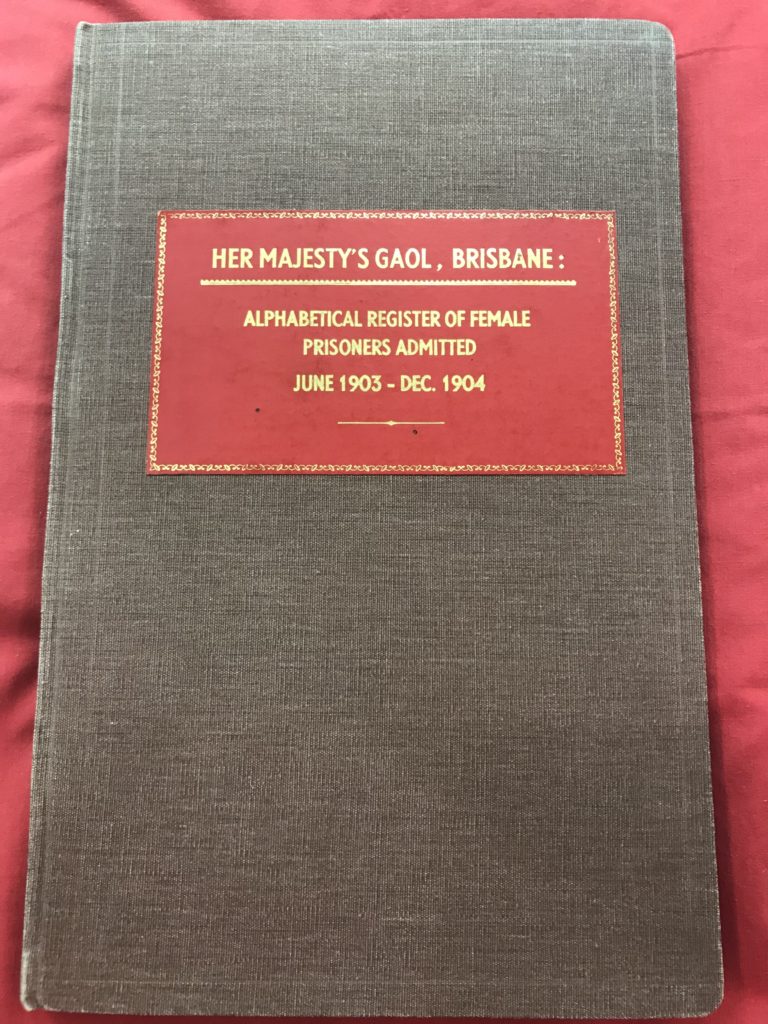
Sadly these records are far from a complete series; however they do cover the initial period where the women were housed in what we now know as number two division Boggo Road Gaol, the only remaining portion of the gaol.
The admission register lists the basics on the prisoner for each admission that they make to the prison. This record is arranged by alphabetical order by surname and then in numerical order by year (for example: 243 /1903 Smith, Agnes) this record goes on to record the sentencing information, the location of their trial, the magistrate that heard the case, and even how the prisoner was disposed of. (For example: how much of their sentence did they serve and their release date)
The description book lists the basic information about each prisoner, such as their full name, place of birth, any aliases that they may be using. Physical information such as their weight, height, eye colour, skin tone and build are also recorded. In some records their level of education and occupation is recorded as well as any prior convictions that the prisoner may have.
As you can see, for the researcher these records give a picture of the prisoner at a time where photographs were not taken. Therefore they become an essential part of the story of Boggo Road Gaol.
The research team hopes that this gives the reader an idea of the types of records that are available for specific research on a particular prisoner in Boggo Road Gaol.
So when you get the opportunity to see the prison players in action, you can understand the level of research that goes into providing the most immersing and accurate portrayal possible.
This Sunday, why not escape the 21st century; leave behind the cars, air conditioning, electricity and modern technology. Bring along the family and show them what life was like before all of the modern conveniences and even some of the things we see as basics to everyday. Click here to secure your tickets.
This article was contributed by Research Coordinator Sue Olsen as part of the ongoing research program for Boggo Road Gaol Pty Ltd. The aim of the program is to bring to light and share articles relating to Boggo Road for the purposes of review and study. Do you have a story to share or something you would like us to know about? You can contact the research team here.
From the headlines: Officer Frank Johnstone
- On : 25 May, 2018
- By : Boggo Road Gaol
- Category : Stories
- View : 1608
From the headlines: Officer Frank Johnstone:
A short story this week; again from the headlines of the Courier Mail newspaper: The remarkable story of the officer who accidentally shot himself with his own pistol!
From the Headlines: Officer Frank Johnstone
The morning started out like any other for Frank; he rose early and dressed for work, eating his breakfast and collecting his lunch and flask of hot coffee from the kitchen table. Hurriedly he kissed his wife on the cheek as he left the door of their Bardon home. Little did he know how his morning would unfold!
The cold winter’s morning had taken its toll on Frank, even before he had arrived at work. He had put on an extra layer of clothing before the ride on the tram to Annerley and the short walk to the gaol.

The bullet flew from the chamber passing through Frank’s right leg, only narrowly missing his fellow officers before lodging in the wall of the armoury.
Frank fell to the floor wounded, the noise from the discharge of the pistol rang out over the prison and all haste was taken in discovering its source.
Frank was seen to at the prison hospital, his wound not being serious he was allowed to go home to recuperate.
A subsequent investigation ruled that the incident was an accident and no disciplinary action was taken against officer Johnstone.
The armoury and likely the bullet remain to this day, inside the gates of number 2 division Boggo Road Gaol. You can see the armoury on any of the tours of Boggo Road Gaol.
Want to know what it was like to be an officer at Boggo Road Gaol? Want to know how easily an accident like this could happen on a cold winter’s morning? Come along this Sunday for our officer tour and meet former officer Kevin Hayden! For more information click here
This article was contributed by Research Coordinator Sue Olsen as part of the ongoing research program for Boggo Road Gaol Pty Ltd. The aim of the program is to bring to light and share articles relating to Boggo Road for the purposes of review and study. Do you have a story to share or something you would like us to know about? You can contact the research team here.
From the Headlines…From Boggo Road to Marry
- On : 18 May, 2018
- By : Boggo Road Gaol
- Category : Stories
- View : 1564
From the Headlines …From Boggo Road to Marry
“From Boggo Road to Marry & Back to 10 Year Sentence” A story from the Headlines of the Truth Newspaper on the 10thof December 1939, tells the remarkable story of prisoner John Daniel Robertson who was given the extraordinary permission to marry while under sentence of ten years at HM Prison Men Brisbane (later known as Boggo Road Gaol)
“From Boggo Road to Marry & Back to 10 Year Sentence” A story from the headlines of the Truth newspaper on the 10thof December 1939, tells the remarkable story of prisoner John Daniel Robertson who was given extraordinary permission to marry while under sentence of ten years at HM Prison Men Brisbane (later known as Boggo Road Gaol)
The Crime
John Daniel Robertson was found guilty of the rape and indecent assault with violence of a young woman in Mackay in August of 1938. He had followed her from her work and dragged her into a laneway and viciously assaulted her.
The victim was able to make an escape and found a nearby policeman; he followed her to the scene and arrested Robertson. A short time later she formally identified him in an interview. Robertson was held for trial before the police magistrate.
The Sentence
In the March 1939 trial, Robertson and his team failed to impress upon the jury and Mr. Justice Douglas of his innocence of the four charges against him. He was found guilty and sentenced to Fourteen years imprisonment with hard labour.
The Appeal
Almost as soon as the cell door had slammed shut on Robertson, His friends and workmates had begun to rally behind him raising the funds for him to be able to appeal his case. He wished to have a new trial, this was denied. However with the review of the case his sentence was changed to ten years with hard labour.
Permission to Marry
In days gone by, it was traditional to ask the bride’s father for permission to marry… In this case permission to marry had to be sought from the minister for home affairs Mr. E.M. Hanlon. It was very uncommon for a long term prisoner to seek permission to marry simply because they were held behind bars for a long period of time. The case was given very close inspection by the minister before giving his permission. The location of the wedding was also a problem. It was out of the question for the wedding to be held inside the gaol. So an alternative location had to be sought.
The Wedding
Romance descended on Boggo Road Gaol that Saturday October afternoon. A prison officer in his civilian clothing entered one of the cells and escorted Robertson to the superintendent’s office. A word of congratulations and wishes for good luck from the Superintendent and Robertson (still under control of the officer) left the gaol precincts for the Holy Trinity Church at Woolloongabba. The wedding was held with great secrecy so as to prevent the public finding out, with the risk that it would turn into some sort of circus with a large number of curious spectators flocking to the site. Under this veil of secrecy only the immediate family of the couple was permitted to attend. A few short minutes after the service was completed Robertson was bundled off back to his cell in Boggo Road with his bride left to entertain the family.
The Aftermath
Robertson no sooner had married that he had sent a request to the parole board for release. He wished to be released into his wife’s custody, with other requirements to be met under the parole agreement.
At the date of this article no decision had been made on his parole.
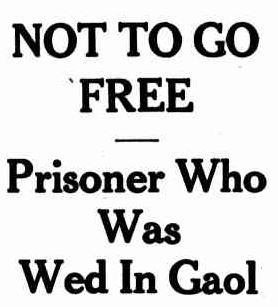
NOT TO GO FREE was the headline. And is perhaps all the reader needs to know.
The article goes on to state:
Robertson is at liberty to lodge a further petition at a further date but the board will not consider his release until he has served a longer portion of his ten year sentence.
Robertson was very certain he would secure his parole. He considered that he had been granted permission to marry; his freedom then on parole should be almost automatic. Reports to the truth from inside the gaol show that Robertson was a very disappointed man when the decision was communicated to him.
So it was, Robertson was locked up in Boggo Road Gaol serving his ten years… waiting for his opportunity to apply for parole again.
This story has so much more to tell… so many unusual twists and turns to be revealed… Perhaps the most unusual that was yet to be revealed to the public we will tell you right now.
The woman he married with such extraordinary secrecy was the same woman that put him in gaol in the first place.
His victim.
This Sunday, you can hear more stories from a prisoner’s perspective. Larry Campbell, a former prisoner at Boggo Road, will guide you through some of the most turbulent years of the Gaol’s history. To book tickets for our fascinating prisoner tour click here.
Did you know that unlike John Daniel Robertson… you can have your wedding in gaol? For more information visit here
This article was contributed by Research Coordinator Sue Olsen as part of the ongoing research program for Boggo Road Gaol Pty Ltd. The aim of the program is to bring to light and share articles relating to Boggo Road for the purposes of review and study. Do you have a story to share or something you would like us to know about? You can contact the research team here
Escape! Ernest Albert Richards
- On : 11 May, 2018
- By : Boggo Road Gaol
- Category : Stories
- View : 1927
Escape! – Ernest Albert Richards
New Years Eve 1931, Notorious habitual criminal Ernest Albert Richards, serving a ten year sentence in Yatala Prison, South Australia walked out of the prison somewhere between midnight and six am. Richards was unknown in Queensland. But he was soon known to Brisbane, more specifically the notorious Boggo Road Gaol.
Escape! Ernest Albert Richards
Notorious habitual criminal, Ernest Albert Richards was very well known in South Australia. Born there in 1903, he was in trouble from a young age; being a ward of the state and not ever wanting to do as he was told. His crimes range from petty theft to robbery with violence. He was unknown to the residents of Brisbane even after committing a sensational violent robbery of a Post Office in Adelaide, South Australia in 1930. For which, Richards gained himself a ten year sentence with hard labour in Yatala Prison. Indeed, it wasn’t until 1932 that anyone in Brisbane knew of Ernest Albert Richards. You see, Ernest had no desire to remain in his solitary accommodations for a new year.
Around midnight on New Year’s Eve 1931, after making the appropriate arrangements, Ernest escaped from his cell, one of the strongest in the prison. His cell was in an island of four cells in the main yard of the prison; used especially for the isolation of troublesome inmates.
The cells were surrounded by a caged yard twenty feet by ten feet in size. Richards was sentenced to four months in this solitary confinement, even doing his work in either his cell or in the attached yard.
Somehow, Richards gained a key and unlocked the four locks on the two outer doors of his cell, climbed up and bent the bars of the top of the caged yard open and using a rope made from his coir mat bedding scaled the outer wall of the prison and vanished into hush of the early morning.
Ernest Albert Richards
Occupation prior to arrest: Electrician and Mechanic.
Known alias : Woolfington and Wilson
Height: Five feet six inches
Build: Medium
Complexion: Fair
Eyes: Blue
Hair: Light Brown
Remarks: Pointed nose and scar on right thumb.
Last seen wearing: White Moleskin trousers, Galatea Shirt and Rope Soled Slippers
Arrest in Brisbane
After weeks of searching in the southern states, word had reached Brisbane that the notorious Ernest Albert Richards could be on his way. Indeed, He was already here. Richards had arrived a day or two prior. At 8pm on the 16th of February in Ann Street Brisbane, A man fitting Richards description was arrested by plain clothes police officers for vagrancy. He was taken back to Roma Street Station and questioned. He immediately admitted his identity and was placed in a cell to appear before the police magistrate the next morning.
Next day in court, the vagrancy charge was dropped and Richards was remanded in custody for seven days in order for the original arrest warrant to arrive from South Australia.
During the surrounding media circus, Richards sold his remarkable escape story to the Truth newspaper. You can read the full story here
To His Majesty’s Prison Brisbane
Richards was sent off to serve his seven days remand in His Majesty’s Prison Brisbane (Later known as Boggo Road Gaol) Surely, the notorious Boggo Road could hold Ernest.
Well, four days later while exercising in the yard, Richards climbed a wooden fence and secured a piece of gas piping that ran along the yard near the wall. He hooked one end over the wall and clambered up it. He was immediately seen by a warder on the watch tower.
Drawing his revolver the warder fired a fusillade of shots, some bullets grazing Richards. Though he managed to make it over the wall and dropped down to the grass outside. He darted on the roadway that runs beside the prison.
Escape!
Richards was seen by Acting Superintendent Whitney from his balcony, who immediately alerted warders in the gatehouse who dashed out the front gates armed with rifles and revolvers firing shots and shouting for Richards to stop.
Richards scrambling down the railway cutting, fell, but quickly recovered; the warders’ followed. One falling heavily, but he recovered enough and fired his rifle. Richards meanwhile was climbing a fence opposite near the Park Road station. The round struck Richards in the left calf. He was wounded, but still managed to make it over a two more fences in Quarry Street.
The wound was slowing him down, it was bleeding badly, and the warders were gaining on him. Richards found his way through some thick bushes into Rev. Atkins back yard and crashing through the netting into the chook run, he hid in a small shed out of sight.
Richards thought if he lay low, this would be a good place to hide. The warders would surely pass him by; but presently a rifle was thrust into his face and he was ordered to come out. Richards was carried by stretcher to an awaiting motor car that swiftly returned him to prison with just nine short minutes of liberty.
 Return to South Australia
Return to South Australia
Three days later, Richards further appeared in the police court Brisbane; the magistrate ruled “ I order that you be returned to Adelaide”. The warrant and his escort had arrived, Richards departed on the Kyogle Train on Friday the 26th of February 1932. On arrival in Adelaide, Richards appeared before the court on charges of escape. He received an additional eighteen months on his original ten year sentence.
Want to see where Richards went over the wall? You can! Join us for our Escapes tour this Sunday! Hosted by Director Jack Sim, you will hear of some of the greatest escape stories from the history of Boggo Road Gaol. To book click here
This article was contributed by Research Coordinator Sue Olsen as part of the ongoing research program for Boggo Road Gaol Pty Ltd. The aim of the program is to bring to light and share articles relating to Boggo Road for the purposes of review and study. Do you have a story to share or something you would like us to know about? You can contact the research team here
Lifers – Frederick Emanuel Lewis and John Wilson
- On : 5 May, 2018
- By : Boggo Road Gaol
- Category : Stories
- View : 2534
Lifers – Frederick Emanuel Lewis and John Wilson.
Shot her down in cold blood!
The most brutal and cold blooded hold up in Brisbane in many years took place at Pope Street off Gladstone Road at Dutton Park at the home of Mr. and Mrs. Richard Stephens from the Paddington Picture Theatre.
Shot her down in cold blood!
The most brutal and cold blooded hold up in Brisbane in many years took place at Pope Street off Gladstone Road at Dutton Park at the home of Mr. and Mrs. Richard Stephens from the Paddington Picture Theatre.
It was 11:30pm on the 30th of January 1932, the Stephens family returned home from the theatre with the evening’s takings. As the family car pulled into the drive way and into the garage they were startled by a loud report. Mr. Stephens thought it was a blow out. Laughingly he said ‘we were lucky to make it home!’
While inspecting the tyres he heard a second report and was met with the shouts of “Stick Em Up! Quickly!” and a revolver pointed at him. He laughed it off and said “Go on, that’s only a pop gun! Clear out or I will get my own revolver to work! the bandit replied… come on Dick… just hand it over! Clearly the bandits knew the Stephens.
A struggle broke out between the two bandits and Mr. Stephens and his fourteen year old son Vernon. Vernon was holding the bag containing the £75 takings; he was felled by a hit on the head with the revolver. Mr. and Mrs. Stephens grappled with both men, Mrs. Stephens swung one aside and screamed for help, As she did the bandit pressed the revolver against her chest and fired. She fell to the ground in a pool of blood.
The bandits fled on foot towards Gladstone Road. Mr. Stephens and Vernon gave chase. The bandits firing at least eight shots at their pursuers, they reached a waiting motor car and escaped firing off a few more shots as they fled.
Not knowing his wife had been fatally wounded, Mr. Stephens attempted to revive her with Brandy. Unfortunately Mrs. Stephens had received a shot to the heart and nothing could be done. Sadly, their youngest son George, seven, was sleeping inside the house and hadn’t heard a thing.
Mrs. Stephens was laid to rest in the Toowong Cemetery.
 Frederick Emanuel Lewis
Frederick Emanuel Lewis
Twenty Five year old Frederick Emanuel Lewis was convicted of the murder of Mrs. Lillian Stephens. He was the eldest son of Frederick and Elizabeth Lewis. Frederick Lewis senior was of Indian descent. He had a prosperous fish and chip shop on Given Terrace at Paddington just a few doors from the Paddington Picture Theatre and next door to the Paddington Hotel (The Paddo Tavern). In the trial he admitted that he was the one that shot Mrs. Lewis, and also admitted to the location of the money. Asking his brother to go and collect it and turn it into the police. Francis, his brother refused to do so and said that he should tell the police himself and they would send someone to collect it. He did.
Death
Frederick Lewis died in the gaol hospital on the 17th of May 1944 of Heart Failure.
Arthur Jones, Senior Warder said that he heard Lewis knocking and went to his cell. Lewis complained of pains in his chest and under his arms and asked for an indigestion mixture. Lewis was already receiving medication for heart troubles and was immediately taken to the prison hospital. Lewis had collapsed three weeks previously from similar trouble. Frederick Lewis was buried on the 19th of May 1944 by K.M Smith funeral directors in the family plot at the Toowong Cemetery.
Inquiry
A few months later, a coronial inquiry was held into the death of Frederick Lewis in front of Coroner J.J. Leahy. His brother Francis was in attendance and gave evidence that he had regularly visited his brother and that he was of good health. After the evidence relating to his death was heard and the certificate of death presented. The finding of the inquiry was that his death was from natural causes. The inquiry was subsequently closed and a report listed in the Courier Mail newspaper on the 14th of July 1944.
 John Wilson (known as Jack)
John Wilson (known as Jack)
The younger of the two, a twenty year old labourer; was the only son of George and Kathleen Wilson. John worked at the Newsagents just down the street from the Paddington Picture theatre. John was equally charged with the murder of Mrs. Lillian Stephens, and sentenced to life imprisonment. He was to serve fifteen years of a life sentence. He was released under remission for good behaviour under a scheme for long termers release after the end of World War Two.
John Wilson was not the person that shot Mrs. Stephens however he set out with Frederick Emanuel Lewis to rob Mr. and Mrs. Stephens of their hard earned takings at the Paddington Picture Theatre. He states for the Truth newspaper that he only received five pounds of the loot… in fact he had just shy of ten pounds on him when he was arrested. Allegedly, he won the money gambling. The remainder of the money was hidden… but as we know the location of that was quickly given up by his co-defendant.
When release, John Wilson turned to the trade that he had learned in Gaol; Tailoring. He returned to live with his aged mother at Stones Corner.
This Sunday, you can hear more stories from a prisoner’s perspective. Wayne Weaver, a former prisoner at Boggo Road, will guide you through some of the most turbulent years of the Gaol’s history. To book tickets for our fascinating prisoner tour click here.
This article was contributed by Research Coordinator Sue Olsen as part of the ongoing research program for Boggo Road Gaol Pty Ltd. The aim of the program is to bring to light and share articles relating to Boggo Road for the purposes of review and study. Do you have a story to share or something you would like us to know about? You can contact the research team here
From the headlines…War work inside Boggo Road
- On : 26 April, 2018
- By : Boggo Road Gaol
- Category : Stories
- View : 2326
From the headlines…. War Work Inside Boggo Road.
This week we commemorate ANZAC Day; the solemn reminder of all those good soldiers that have served for the freedoms that we enjoy today. It is also a time to remember those that are still serving in places over the globe. The prisoners of HM Prisons Brisbane (later known as Boggo Road Gaol) did their bit for the war effort. ANZAC Day was commemorated in Gaol just as it is in the freedom of society. Perhaps the most unknown fact is the war work which was undertaken by prisoners in Boggo Road.
From the headlines of the Truth Newspaper we share that five of the worst murderers in Queensland were engaged in war work. The article tells in remarkable detail the work that they are undertaking and a little detail about their individual crimes.
Prisoners of Boggo Road Gaol are on the warpath! They’re in an all-in battle to lick Hitler and his offsider, the scrawny little Tojo. The toughest of them – like mail train killer Herbert Kopit, hammer slayer Percy Airs, Cunnamulla killer James Callaghan, boy gunman Derwent Arkinstall, and murderess Vera Staines, are working for the United Nations – and working well.
Valuable war work is being done as is shown by figures made available by the State Controller-General of Prisons, Mr. J. F. Whitney.
Goods manufactured, treated or repaired by the prisoners – mostly by long term men- include: Many thousands of military trousers and tunics. More than 87,000 arm bands. Sand mats. Flags. Army and Air Force boots and shoes. Tents and Tarpaulins. Hurricane lamps and boilers. Matting. Socks. Literally a score and one other military requirements.
“We think the prisoners are doing a real good job Mr. Whitney told Truth. It is most encouraging to the officers of the department to see the
enthusiasm with which they go about their war jobs. “
“They are honestly pleased with the knowledge that although they are social outcasts- some for life- they are doing something to help the war effort. “
Figures showing value of items produced per department for the year to date:
Tailoring Shop: £15,000
Bootmakers Shop: £3,000
Tinsmith’s Shop: £1,000
Carpenter’s Shop: £300
Bookbinders, Mat makers and Brush makers too all excelled themselves.
Sports gear for diggers
Many a digger playing cricket in New Guinea or in one of the forward areas, has wielded a bat made by prisoners in Boggo Road! That bat has been shaped from wood on one of the prison farms. The timber was felled by prisoners, it was hauled to sawmills and cut up by prisoners in prison mills! Cricket Bats, stumps and bails by the hundreds have by gaolbirds from prison grown and prison treated timber.
The Lifers
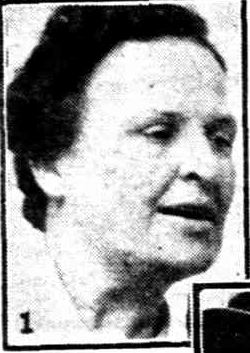
Sentenced to life imprisonment in 1942 she has become a model prisoner. She particularly asked to be allowed to go on ‘war work’. She has been seamstress and maker of military shirts.
2. Herbert Kopit – Bundaberg mail-train killer.
Kopit’s job has been on a button holing machine. He has been commended for the way he turns out military tunics. He seems to genuinely appreciate them.
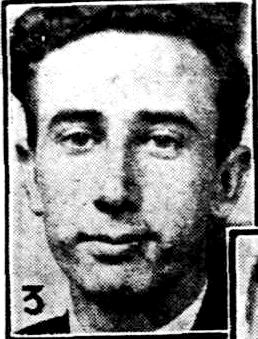
Record keeper for war work done in the prison
4. James Callaghan – Cunnamulla bore-drain murderer
Works in the tinsmith shop principally repairing hurricane lamps, tin mugs and plates.
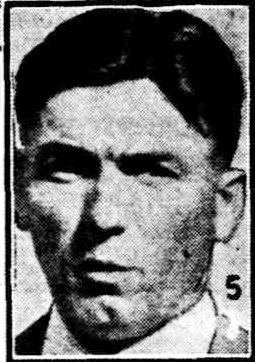
Airs works hard with cutting-out scissors. He likes the job. Airs never misses a news session on the gaol wireless. He follows every act of the war drama with the closest interest.
They’re making shirts, shoes and shovels, mending boots, blankets, trousers and tunics. Every metal sprig they drive into leather, every stitch they insert into a piece of cloth is just another blow delivered for the Allies. They’re a strange mixed lot these Boggo-road lifers. But they’re helping to fight this war for us.
Some would say it is a prisoner’s duty to contribute to the war effort. After all, they were criminals and should work for their keep. Some would say it is good to see that they volunteered to help produce items that would be used in the war. Whichever way you look at it, it was a remarkable achievement. Remember these were not tradesmen. They learned their trade through practice. The sheer number of items produced is astounding.
At the going down of the sun, and in the morning; we will remember them.
Lest We Forget.
Want to know more about these lifers? You can find their stories in the Gaol Shop! Many wonderful publications are available for purchase. These publications are written by Director Jack Sim in conjunction with other local authors. You can order in person or online. So why not visit the Gaol Shop today?
This article was contributed by Research Coordinator Sue Olsen as part of the ongoing research program for Boggo Road Gaol Pty Ltd. The aim of the program is to bring to light and share articles relating to Boggo Road for the purposes of review and study. Do you have a story to share or something you would like us to know about? You can contact the research team here

